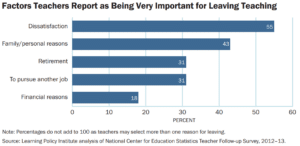Finders keepers, losers weepers
“Help
I need somebody
(Help) not just anybody
(Help) you know I need someone
(Help)”
New school year, same old problems! After a well-deserved break, school administrators come back to find that part of their staff has left them hanging and, while staff shortage is seen as the Achille’s heel of ELT, few managers are willing to dig deep enough and invest in retention. The pandemic and the change in how people perceive their family lives, or the newfound love for working from home in flip flops are strong and easy arguments to explain the shortage, but is it the whole picture?
The pandemic exposed the gaps in education, but it barely scratched the surface when it comes to making visible all the work that goes into making a well-oiled school: the high levels of stress; the unpaid late hours spent preparing lessons and grading papers; the jam-packed classrooms; the unreliable technology; the endless red tape that goes into documenting students’ development. Teachers report feeling stressed, unsupported, and undervalued, which ultimately affects their job satisfaction and leads to turnover.
The teacher turnover rate has increased in all areas, but school administrators seem to find it especially higher among language teachers. Foreign language teachers are known for being unique and multi-competent (Cook, 2016), often entering the profession through alternative certification pathways, which makes them an asset to recruiters searching for professionals who can handle the demands of a bilingual program. Their interest in pop culture, good transit in social media, and ample access to free education apps gives them leeway for narrowing the generation gap between teachers and their digital-native students. Nevertheless, those same traits make them more inclined to leave the job, or the profession altogether, if they can’t find the support to meet their aspirations.
Who foots this bill? Students, as usual. Teachers have a strong influence on students, but this bond takes time and effort; high turnover hampers, not only student motivation (and discipline), but also their academic performance. By forcing schools to hire inexperienced teachers, chronic turnover increases the cost of recruiting and training, affecting the operations as a whole. Since replacing teachers who leave is, invariably, the most costly alternative, the safest bet to curb teacher turnover would be a long-term commitment to improving the learning environment and working conditions, and the first step to doing that is listening to the teachers. Investing in retention, not only benefits the teachers but also the students who rely on them. By reducing turnover, schools can ensure that their students have consistent, experienced, and effective language teachers who can help them reach their academic goals.
There is no real change without a real perception of the problem. Bohm (2004) suggests that “The purpose of dialogue is to reveal the incoherence in our thought”. So, let’s bite the bullet and try to understand the real reason why they are leaving. While some may guess it’s to pursue another job or to seek higher pay, reports from the Learning Policy Institute show that most of them leave of their own volition due to dissatisfaction or for personal reasons, and quite often choose to leave for places with similar or lower pay with a healthier business culture.

Finding and keeping good teachers requires more than just offering higher pay or bulky compensation packages. Higher pay or bulky compensation packages are important, but they can only go so far as to ensure retention. While a scholarship for the kids, a gym membership, a health plan, or food tickets can attract new teachers, only a healthy environment can make them stay. Finders keepers, losers weepers; it’s all about finding the perfect match or, better yet, creating the perfect match.
To enhance the talents that have already been recruited and build a strong language team, schools should invest in ongoing in-service training programs, that not only improve teachers’ qualifications and skills, but also enable collaboration between peers, welcome autonomy, and offer opportunities for advancement. “It cannot be stressed too much that team learning is a team skill. A group of talented individual learners will not necessarily produce a learning team (…). Learning teams learn how to learn together” and that should include every single member of a team, even leaders (Senge, 1990).
A supportive leader is the base of a tight-knit team. Having a solid strategic plan with the vision, mission, and values of a school will not guarantee a healthy business culture if it does not resonate with your team. A good leader should have a well-thought-out strategic plan that is shared with coordinators and teachers. There’s no room for micromanagement and control if the goal is to empower people. According to Senge (1990), “the practice of shared vision involves the skills of unearthing shared “pictures of the future” that foster genuine commitment and enrollment rather than compliance.” It comes down to dreaming together and doing together.
It is crucial for school administrators to address the root causes of teacher turnover in order to create a positive and supportive work environment. Schools must take a long-term approach that focuses on improving the learning environment and working conditions, as well as investing in ongoing professional development for their staff. Leaders must create a healthy business culture that supports and empowers their team, and values open communication and collaboration. Creating a culture of respect, trust, and growth is key to retaining talented teachers and ultimately benefiting their students.
Further readings:
Song: Help, by The Beatles.
https://eric.ed.gov/?id=ED606805
Peter M. Senge, The Fifth Discipline: The Art & Practice of The Learning Organization.
David Bohm, On Dialogue.
https://www.qualtrics.com/experience-management/industry/teacher-retention/
http://portalcoleta.com.br/index.php/rcc/article/view/49
https://as.vanderbilt.edu/french-italian/wp-content/uploads/sites/72/Scott-article-proofs.pdf




